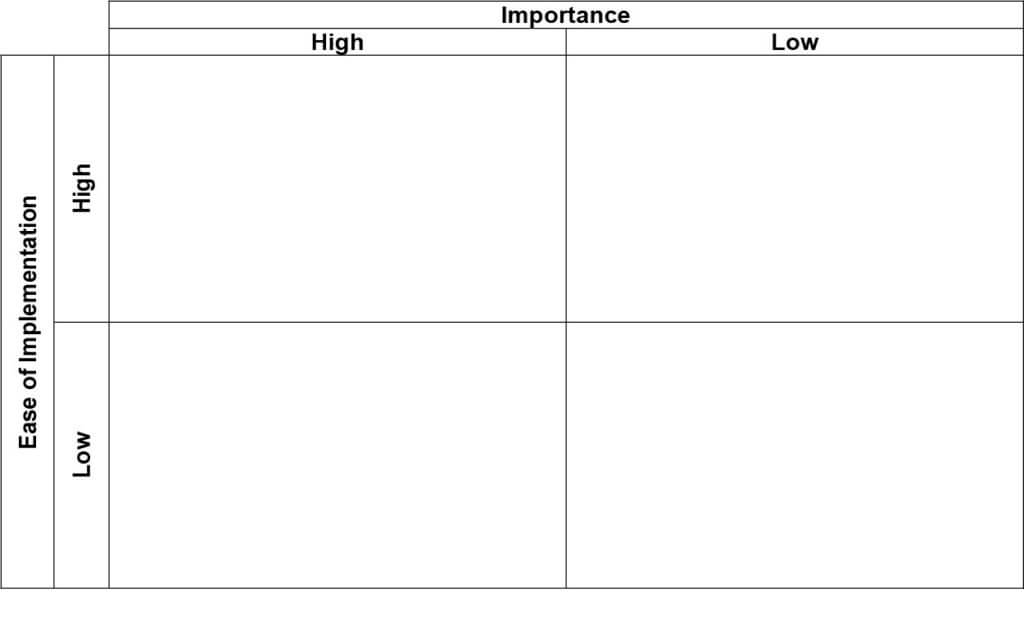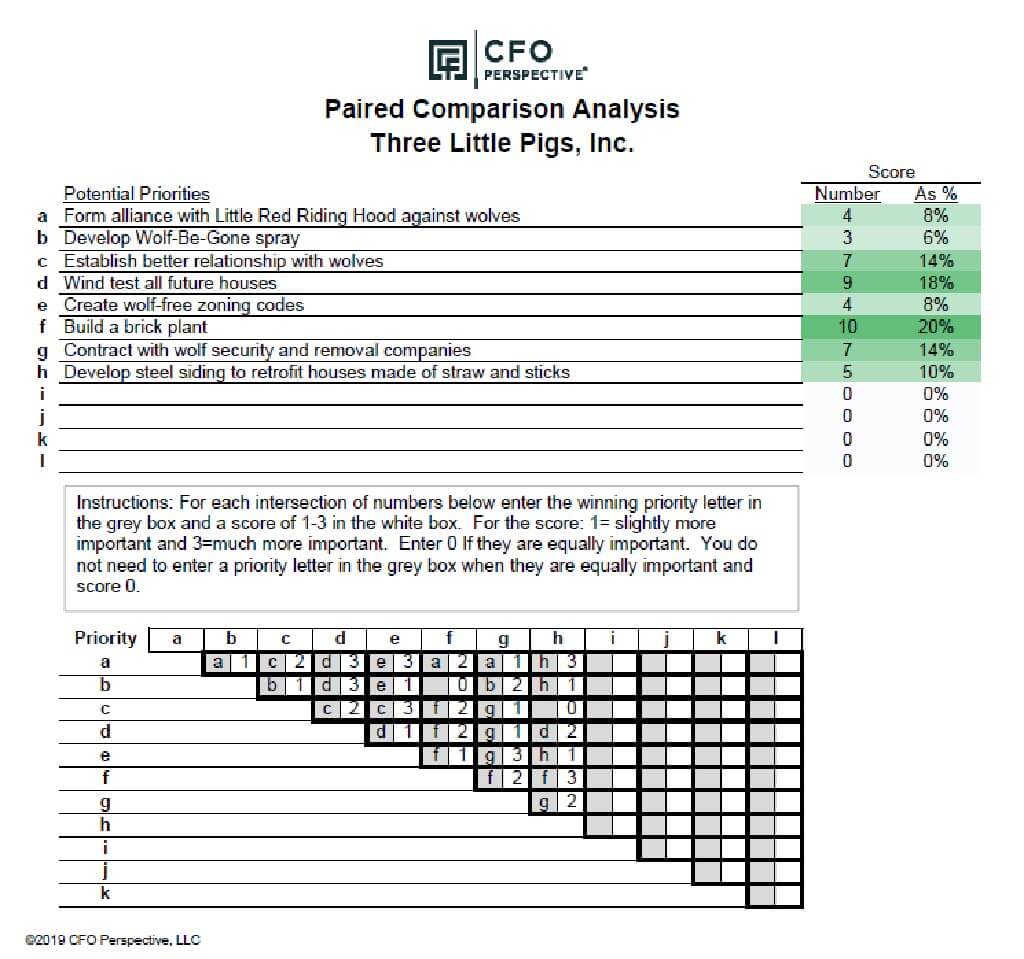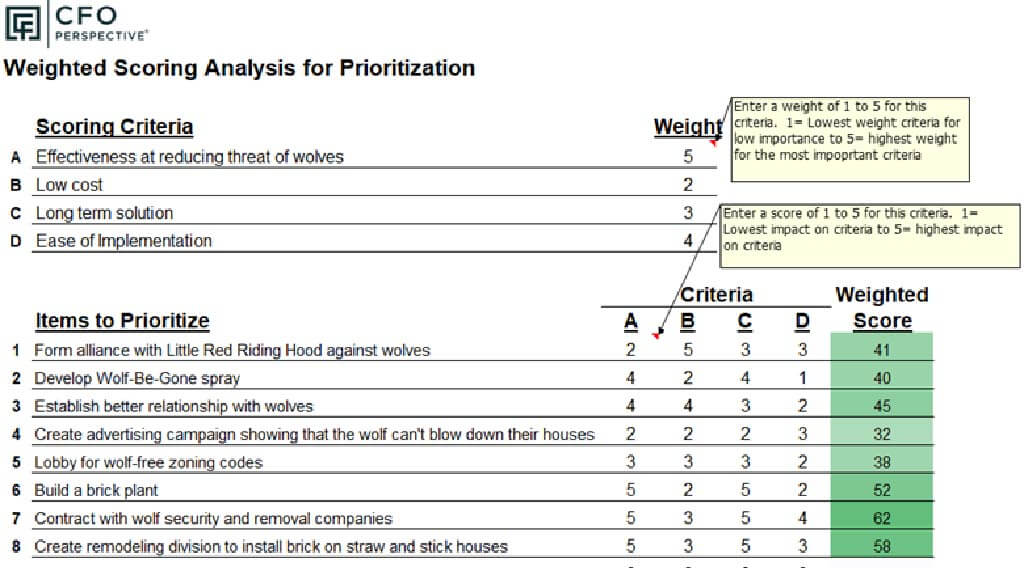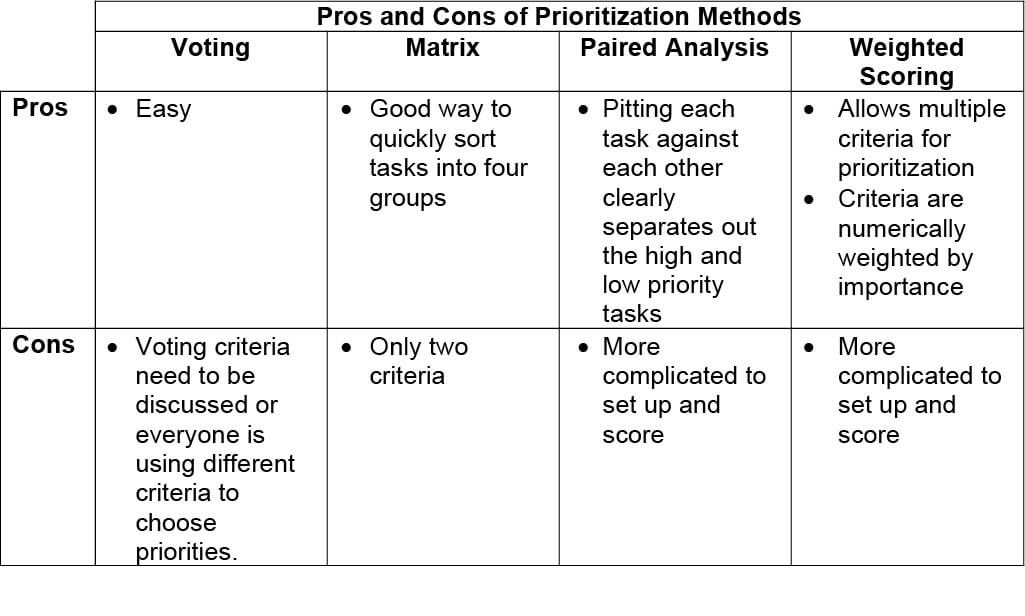Use these four methods to prioritize goals and tasks to focus on what’s important.
You have lots of ideas. It’s time for action. It’s time to pick one thing and get it done. What’s most important? I’ll show you some practical ways you can prioritize goals and tasks.
Carefully choosing what to do next is time well spent. When everything is a priority, nothing is a priority. Employees are scrambling to keep up with too many tasks. Everyone is frustrated by the lack of direction. Deadlines are missed.
A critical skill of CEOs and CFOs is to help set strategy and then measure what’s important for that strategy. Strategic planning is deciding what to do and what not to do with your scarce resources. You don’t have the time and money to do everything.
When everything is a priority, nothing is a priority
Four options you can use to determine the importance of goals and tasks are:
- Voting
- Matrix
- Paired Comparison Analysis
- Weighted Scoring
Voting
A common way for groups to come to a consensus is through voting. The steps are simple:
- Compile a list of items on a whiteboard or poster paper.
- Each person casts 3-5 votes by putting a dot sticker or making a mark by the item on the whiteboard or poster paper.
Voilá! The highest votes determine prioritization.
But something very important is missing in the process above. You don’t have a common criteria for voting. Everyone is assumed to understand the criteria for what’s important.
To identify and correct this weakness, ask each person in the group the criteria they are using to cast their votes. Ask how they define importance. Is it sales, income, efficiency, quality, etc.?
You may find that you now need two voting processes.
- List and vote on the potential definitions of “importance” or other prioritization criteria
- Now vote on the list of goals, tasks, or other items based on the prioritization criteria vote in #1 above.
You can also use vote #1 to determine the criteria when using the other prioritization methods I discuss later.
Here are a couple of other considerations for this method:
Cumulative voting
Cumulative voting means people can cast all their votes on one item instead of limiting them to one vote per item. I recommend cumulative voting to better reflect how well each item meets the prioritization criteria.
Veto Power
The owner or CEO may be given veto power over any decision by the group. They should use this power very sparingly. A veto can be seen by the group as a personal whim and undercuts the power of the group. Another option is for the owner to set the expectation that the process is advisory and that the owner will then make the final decision.
The Matrix
I’ve developed a matrix available to FAST members to prioritize goals and tasks. It’s used in the strategic planning process to choose three-year priorities and annual goals. I’ve also used it when helping clients decide which tasks are most important to move from one employee to another.
Here’s how the matrix works. Write on sticky notes the goals, tasks, or other items that you want to rank. Only one item goes on each sticky note.
Draw the grid below on a whiteboard or on poster paper.

If you don’t have the whiteboard size to make the grid, then create four poster papers with the following titles:
- High Importance and High Ease
- High Importance and Low Ease
- Low Importance and High Ease
- Low Importance and Low Ease
You could also use Microsoft Planner or Trello to do this process on a projected computer screen. Everyone’s goals or tasks can be emailed before the meeting to someone who creates a list of them as tasks in Planner. Create four boards in Planner with the four titles above. The starting screen would look like this:

This matrix sample assumes that importance and ease are the main two criteria. It’s a good starting point but you may want to pick other criteria by using the vote #1 method I described in the voting section. You can identify a more precise definition of “importance” to use as the dimensions on the matrix. You may identify something other than “ease of implementation” as the second dimension.
Everyone places each sticky note in the quadrant or board that best matches each of their tasks. The definition of importance changes depending on what you’re prioritizing. For example,
- For overworked employees, it means reasonable workloads that prevent burn-out.
- Deadlines may drive importance and prioritization
- Importance may be determined by return on investment, internal rate of return, or some other financial metric.
Here is the priority of the items if you are using “Importance” and “Ease of Implementation” as your prioritization criteria:
- Start with the tasks that are the highest importance and the easiest to implement (the upper left quadrant or board #1). Also include tasks that are difficult to implement but have extremely high importance.
- Move next to the remaining tasks that have high importance but are not easy to implement. The group may discover an easier way to implement the item or agree to commit the resources needed to complete the item.
- Next, look over the items that are easy to implement but low in importance. They shouldn’t be a big focus of the organization. You can assign easy ones to a person or department for a quick win.
- Finally, keep a list of items that are both low in importance and low in ease of implementation. Someday you may identify an easier way to implement them or they may become more important in future years. Consider them again the next time you do this exercise. Spend as little time and resources on these items as you can.
Never do what’s easy at the expense of doing what’s important. You can see from the order of prioritization that importance trumps ease. When you don’t do formal planning, items that are urgent or easy often get priority over items that are truly important to the company’s success. Good planning keeps you focused on the right things.
Paired Comparison Analysis
Paired comparison analysis is a way to score each option’s importance compared to another option. A score of 3 means one option is much more important than the other. You note the letter of the option that’s more important. A score of zero means the two options are equal. Below is a sample. In this sample, the fabled “Three Little Pigs” are looking for the best way to stop wolves from blowing down pig houses.

Weighted Scoring
This method is more complex but works best when you want to score the items across multiple criteria. The steps are:
- Compile a list of scoring criteria (for example, return on investment, ease of implementation, customer satisfaction, customer value creation, etc.). Limit the list to just the most important criteria. The weighted scoring process is an excellent method for balancing more than one measure of importance.
- Give a weighting of 1 (low) to 5 (high) to each criterion.
- Score each prioritization option from 1 (low) to 5 (high) based on how well they meet each criterion.
- Total the scores of each item by summing the weighting of each criterion multiplied by each score. An example of the math for the total score of item #1 below is the score for criteria A times weight for criteria A plus the score for criteria B times weight for criteria B, etc. The sample numbers below are (2 X 5 )+ (5 X 2) + (3 X 3) + (3 X 4) = the weighted score of 41.
- The highest priority items are the ones with the highest scores.
Below is an example of how this works.

This is the best method to use when you have competing criteria and many goals. You can do the weighted average process alone or with a group of people. Email the scoring sheet so people can score it at their convenience and send it back to compile everyone the totals from everyone’s results. Add up the weighted scores from everyone to determine the items that have the highest total scores across your company.
Picking the Best Process to Prioritize Goals and Tasks
Here’s a summary table of the pros and cons of each of the four prioritization processes:

The options range from simple to slightly complex. The more complex methods are better for larger groups of people or larger amounts of items to prioritize. Pick the method that fits your company and gain the clarity needed for focused performance.
For more info, check out these topics pages:
